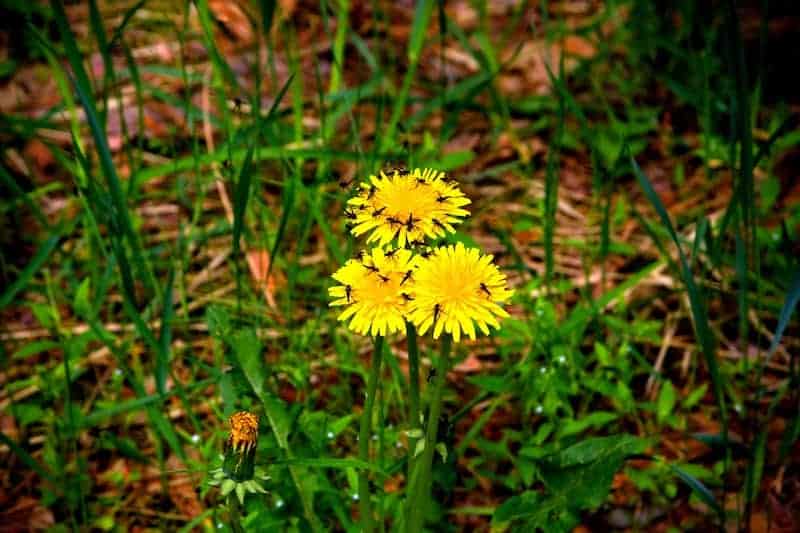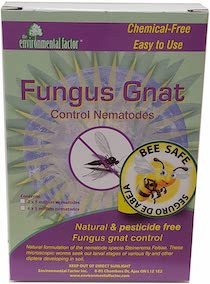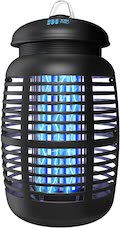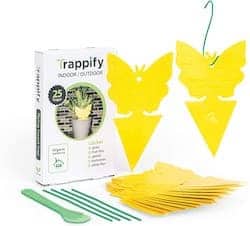8 Natural Ways to Rid Your Yard of Gnats
Last spring, I experienced a huge infestation of gnats in my yard. For months I tried to figure out how to get rid of them in the most effective, safe way possible. After hours of research looking for a natural way to get rid of gnats outside, I finally found a few options that work.
How can you naturally get rid of gnats in your yard? There are two main avenues of naturally getting rid of gnats: environmentally and/or biologically. Environmentally, you should pick up the dead leaves and grass clippings laying in your yard and increase the time between watering your lawn. Biologically, you can introduce some natural predators of gnats to the affected area and let nature take its course.
Thankfully, there are several ways to get rid of the gants in your yard, allowing you to have the best grass for bare feet once again. Keep reading and see if these steps can work for you too!
Typical Behavior of Gnats
Before you start your crusade to get rid of those annoying little bugs, it might help to understand a bit more about how they live and what to expect from them. Gnats have four stages of life: egg, larva, pupa, and adult.
During their second stage of life, gnats feed on the roots of plants and other organic material in the soil – though much less damaging than other plants, feeding on the soil and roots can impact the health of the plant in the future.
What creates an inviting environment for gnats to lay eggs and live? Warm temperatures and abundant water. This is why you’ll start to notice gnats around the warmer spring and summer months. The adult gnats are the ones that swarm around you and get in your face.
Although they are irritating, they do not harm plants or people. Normal behavior for adult gnats is to drink water on plants and inhabit the areas where they lay their eggs.

Here are 8 Ways to Get Rid of Gnats Naturally:
- Remove any dead organic material
- Use Nematodes
- Gnat Trap
- Bug Zapper
- Remove Fruity Scents
- Use Scents that Repel
- Use Plants to Repel the Gnats
- Use Gnat Sticky Traps
Start With Your Environment
1) Make your yard uninhabitable by removing dead leaves, grass clippings, old mulch and dead plants.
One of the easiest ways to prevent and reduce the number of gnats inhabiting your yard is to make sure that the environment is unsuitable for their survival. To do this, you should do your best to make sure the dead and decaying matter in your yard is picked up.
Rake the dead leaves, bag grass clippings, remove dead plants, etc. After this is done, start spreading out the time between watering your yard and plants. Let the area dry more thoroughly between watering.
A couple of other things you can do is avoid using peat moss beds – they are a favorite of fungus gnats, and hang flypaper strips in areas most commonly swarmed by gnats. If you hang flypaper strips, make sure you change them often. Along with flypaper strips, other home-remedy mixes will lure the gnats before trapping them.
Though these steps may seem trivial and too easy, changing the conditions in which gnats thrive can make a big difference in the numbers surrounding your yard.
 Biological Options for Dealing with an Outdoor Gnat Infestations
Biological Options for Dealing with an Outdoor Gnat Infestations
If after you have made the simple environmental changes to your yard and are still experiencing a large infestation of gnats, the next step is to introduce predators of gnats into the area as a way of controlling their numbers.
2. Introduce Nematodes into Your Yard
There are two different types of roundworms – technical term nematodes, that are effective in reducing the number of gnats. Steinernema feltiae and the second is Steinernema carpocapsae. Both are easy to find and order online or at garden and plant shops.
Once you acquire the roundworms, make sure you follow the instructions on the package as you introduce them to the area where your gnats are congregating most heavily. You must use a larger than the normal amount, and repeat the application until you begin to see a reduction in the number of gnats outside.
3. Gnat Trap (Vinegar, Dish Soap and Sugar)
In a small bowl, mix together half cup of warm water plus two tablespoons of apple cider vinegar and one tablespoon sugar. Add six drops liquid dish detergent for extra sudsing power! Gnats will be lured in by the sweet mixture, but once they dip into it to drink some juice up… that’s when you’ll see them get stuck on top of the soap bubbles! Simply place this little gnat trap on your porch or any areas where you’ve noticed the most bugs flying around; wait 4-8 hours (or overnight) before examining your trap.
4. Bug Zapper
When it comes to keeping your home free of pesky bugs, a bug zapper is an all-time favorite. Although these devices are designed for larger insects (like mosquitoes), the new models work just as well on gnats and flies too! Unlike their old counterparts that screeched with every catch, modern versions can be used outdoors without being obnoxiously loud — you’ll never know they’re even there until you see one go pop in front of your eyes. With no risk or effort required from yourself, this may very well become the best part about having outdoor parties after sunset again.
5. Remove Fruity Scents
While gnats have a sweet tooth like many other creatures on the planet and enjoy a smell of fruit from time to time. If there is any good news here it would most likely be that if they’re buzzing around your yard then it means you’ve got something delicious smelling in you yard. It could also mean that one wrong move with some sticky lotion will make them think it’s juice nectar.
Gnats are naturally drawn to fruity scents from your shampoo, body wash, or perfume. In fact, the aroma of these products may make you a desirable target for these pesky flying pests.
6. Use Scents that Repel Gnats
You’ve got to start with a plan of attack against those pesky gnats and host other pests! One way is by using essential oils. Lavender, vanilla, citronella oil are all great along with tea tree aromatherapy. If you want an even more powerful solution for your home or office use peppermint essential oils diluted in water as well as rosemary – it’s the perfect soothing scent when blended together; not too strong but enough to make sure that there won’t be any gnats buzzing around nearby again soon!
7. Use Plants that Get Rid of Gnats
Variety is the spice of life and when it comes to gnats, you can keep them away with a variety of plants. The wonderful thing about using plants is that not only do they look nice in your garden, but they will also help keep more than just gnats away! Just be sure to plan things strategically so as not too overcrowd certain areas or forget another section altogether.
Planting a garden of herbs and flowers is an excellent way to keep pests away. If you’re looking for more natural ways to deter gnats, try planting geraniums, lemon thyme, lavender or Mexican marigold near your outdoor space as these will keep the pesky bugs away!
8. Use Gnat Sticky Traps
The sticky trap is a great way to catch those pesky gnats. Place it in the yard and watch as they get stuck on that bright yellow color. The glue will keep them from escaping, so not only can you enjoy your yard but also be free of pests!
When Should You Expect to See Gnats?
Depending on the area in which you live, spring weather is often accompanied by warmer temperatures and a decent amount of rain. Humid, semi-warm environments are extremely inviting and habitable for gnats. This is why you start to see them as warmer spring temperatures give way to summer.
Mid-May to late June is the most likely time frame in which you will see and experience gnats swarming your environment. Even though they have a short lifespan – about 18-30 days long, gnats can reproduce new populations within 17 days. This is the reason why infestations can become overwhelming and difficult to reduce.
The good news is, as warmer summer temperatures start getting more consistent, the gnat population will begin to die off.
Can Gnats Harm Your Plant Life?
Adult gnats are primarily a nuisance – they do not damage plants or bite people. In the larva stage, they will feed on the roots of plants and the surrounding soil, but they are unlikely to cause any damage. Because the life cycle of gnats is so short, some won’t even eat at all during their adult stage.
Basically, they live to lay eggs, birth a new generation, and annoy people who are just trying to enjoy the nice weather!
In reality, they are beneficial to birds and other insects as part of the food chain, and they can be helpful with pollination. Though pests like gnats can drive everyone crazy, they still do have a purpose and are valuable in keeping the natural environment healthy.
Protecting Indoor Plants from Gnats
So your house plants have been infested with gnats and you don’t know what to do? The good news is, gnats are much less damaging than other pests and easier to get rid of than you might think.
You’ll notice if your plants have gnats because their population grows quickly and they will be confined to the area immediately surrounding the plant. You will also notice them if you look through the soil of your plant, as there will likely be more gnats going through every stage of their life cycle.
Opposite to when outdoor gnats appear, it’s more common to see indoor gnat infestations during the winter months – they’ve come in to stay warm. The easiest way for an indoor infestation to occur is when you’ve brought in any plants from outside that already had gnats in the soil.
More good news: you can get rid of indoor gnats naturally, with the same steps as you would an outdoor infestation.
- Avoid overwatering your plant – this will prevent gnats from choosing this plant as their new home, but it will also disrupt their reproductive cycle by reducing the population already there.
- Use sticky traps – place them on the top of the soil and any adult gnats swarming around will be attracted to them and get stuck. You can also create your own sticky traps by mixing cider and vinegar and putting it in a dish near the plant.
- Introduce natural biological predators – the same roundworms you would use outdoors can be used inside as well. You will likely not be able to see what’s going on as they’re quite small, but don’t worry! The roundworms are doing their job and killing the gnats in the soil.
Enjoy Your Spring and Summer Pest-Free!
If you’ve completed the previous steps of environmentally and biologically creating a healthy and safe atmosphere that successfully controls the number of pests swarming your yard – you are on your way to enjoying the warmer months!
By taking the time to use natural remedies, you have already improved the quality of your plant life for the future, as well as protect your budget and the lives of your family and animals. Additionally, by preventing unnecessary damage to your home and yard, you will avoid the potential for a home insurance claim.
You decided to be responsible for safeguarding the environment and reducing unnecessary pollution – for that you should and will be rewarded by a beautiful, pest-free yard and garden this spring/summer.
Related Questions
Why would a natural solution be better than a chemical one? Apart from making the environment a better place by reducing pollution and conserving natural plant life, using a natural intervention to get rid of unwanted pests also protects you, your family, and your animals from unhealthy chemicals.
Fertilizers and pesticides are poisonous to water sources, soils, and living creatures. Despite extensive advertising that proclaims their effectiveness, pesticides will kill more than the annoying creatures you’re aiming for – they will also kill the helpful insect life. Aside from being harmful to the environment and other living things, pesticides are expensive.
Why would you spend money on risky and unsafe methods of getting rid of gnats, when you could find simple, inexpensive ways of controlling the population infesting your yard? If you weigh the pros and cons, it will be apparent that going natural is much more advantageous and effective than any chemicals would be.
Thank you for reading American Lawns! You can find more lawn tips from experts here.




